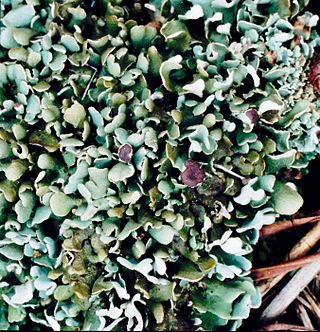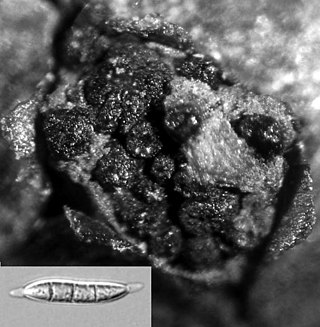Related Research Articles

Lecanoromycetes is the largest class of lichenized fungi. It belongs to the subphylum Pezizomycotina in the phylum Ascomycota. The asci of the Lecanoromycetes most often release spores by rostrate dehiscence.

Peltigerales is an order of lichen-forming fungi belonging to the class Lecanoromycetes in the division Ascomycota. The taxonomy of the group has seen numerous changes; it was formerly often treated as a suborder of the order Lecanorales. It contains two suborders, eight families and about 45 genera such as Lobaria and Peltigera.

The Lecanorales are an order of mostly lichen-forming fungi belonging to the class Lecanoromycetes in the division Ascomycota. The order contains 26 families, 269 genera, and 5695 species.
Neocryptospora is a genus of fungi within the class Sordariomycetes. The relationship of this taxon to other taxa within the class is unknown. According to the 2007 Outline of Ascomycota, the placement in this class is uncertain. The genus is monotypic, containing the single species Neocryptospora rickii, described by Austrian-Czech mycologist Franz Petrak in 1959.

The Melanconidaceae are a family of fungi in the order Diaporthales, class Sordariomycetes.
The Microthyriaceae are a family of fungi with an uncertain taxonomic placement in the class Dothideomycetes.
The Parmulariaceae are a family of fungi with an uncertain taxonomic placement in the class Dothideomycetes.
The Amorphothecaceae are a family of fungi in the division Ascomycota. This family can not yet be taxonomically classified in any of the ascomycetous classes and orders with any degree of certainty. It contains the single genus Amorphotheca.
The Diporothecaceae are a family of fungi in the Ascomycota phylum. This family can not yet be taxonomically classified in any of the ascomycetous classes and orders with any degree of certainty. It contains the single genus Diporotheca.

The Pseudeurotiaceae are a family of fungi in the division Ascomycota. This family can not yet be taxonomically classified in any of the ascomycetous classes and orders with any degree of certainty.
Ochrosphaera is a genus of fungi in the Ascomycota phylum. The relationship of this taxon to other taxa within the phylum is unknown, and it has not yet been placed with certainty into any class, order, or family. This is a monotypic genus, containing the single species Ochrosphaera meliolae.
Phylloporina is a genus of fungi in the Ascomycota phylum. The relationship of this taxon to other taxa within the phylum is unknown, and it has not yet been placed with certainty into any class, order, or family.
Porosphaera is a genus of fungi in the Ascomycota phylum. The relationship of this taxon to other taxa within the phylum is unknown, and it has not yet been placed with certainty into any class, order, or family.

The Rhytismatales are an order of the class Leotiomycetes within the phylum Ascomycota.

The Thelebolales are an order of the class Leotiomycetes within the division Ascomycota. It contains the single family Thelebolaceae, circumscribed in 1968 by Finnish mycologist Finn-Egil Eckblad.

The Lasiosphaeriaceae are a family of fungi in the Ascomycota, class Sordariomycetes.

The Ascosphaeraceae are a family of fungi in the Ascomycota, class Eurotiomycetes.
The Gymnoascaceae are a family of fungi in the Ascomycota, class Eurotiomycetes.

The Capnodiaceae are a family of fungi in the Ascomycota, class Dothideomycetes. Species in the family have a widespread distribution, and are especially prevalent in tropical and subtropical areas, as well as temperate rainforests.
References
- ↑ Lumbsch TH, Huhndorf SM (December 2007). "Outline of Ascomycota – 2007". Myconet. Chicago, USA: The Field Museum, Department of Botany. 13: 1–58. Retrieved 2015-09-24.